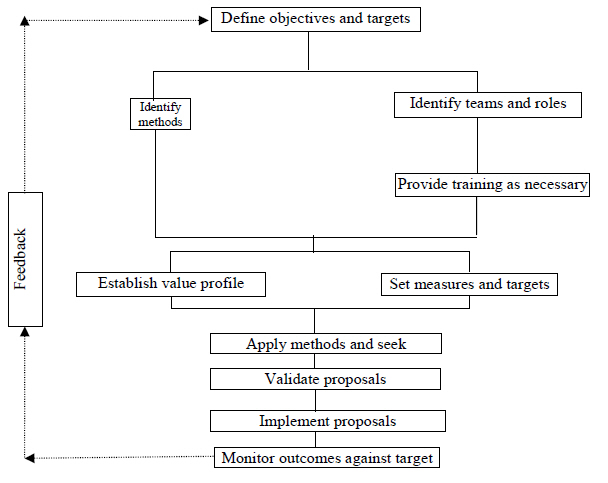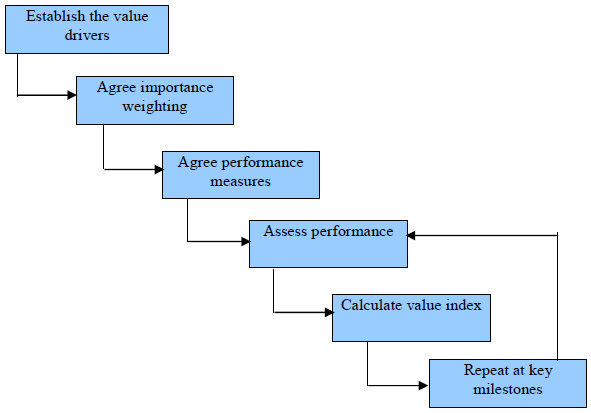Value in building design and construction
Contents |
[edit] Introduction
Value relates to the assessment of the benefits brought by something in relation to the resources needed to achieve it. In the context of construction projects it is normally expressed as a ratio between a function and the whole life cost for that function.
Value = Function / Whole Life Cost
or
Value = What you get (or want) / What you pay
Thus, value can be increased by improved function or reduced whole life cost. Value for Money (VfM), as a concept, relates to the optimum balance between the benefits expected of a project and the resources expended in its delivery.
The three most common terms associated with the VfM concept are value management, value engineering and value analysis. While they are all keys to the VfM concept, there are functional and systemic differences between them:
- Value Management (VM) is about getting the right project.
- Value Engineering (VE) is done to get the project right.
- Value Analysis (VA) relates to the improvement of a construction, manufacturing or management process and also to a post-project review to establish value achievement.
The British/European Standards define VM as 'a style of management, particularly dedicated to mobilise people, develop skills and promote synergies and innovation, with the aim of maximising the overall performance of an organisation' (BS EN 12973: 2000).
An alternative functional definition can be 'Value Management (VM), is a systematic and structured process of team-based decision making. It aims to achieve best value for a project or process by defining those functions required to achieve the value objectives and delivering those functions at least cost (whole-life cost or resource use), consistent with the required quality and performance' (Hamersley 2002).
The essential principles of VM place emphasis on it being a continuous process within a structured framework.
[edit] Understanding the concept of value
Value is probably one of those things that everyone understands but no two people will describe in the same way. It is not something tangible and is often quite difficult to measure or quantify. Yet, it is one of the key and perhaps most powerful concepts in the market.
Value is subjective, prone to perceptions and pre-conceived notions. But for teams undertaking VM exercises it is absolutely essential that value is measured and quantified.
Early pioneers of VM identified three factors influencing value:
[edit] Utility
Will it work effectively and do what it is expected to do? Most buildings are constructed in order to accommodate and support specific activities. The building will be judged a failure if it does not do this effectively. Thus, maximising the productivity of what is done is a key component of the utility value in many buildings.
A similar concept applies to civil structures such as roads and bridges. If a new power station is built, it must generate power reliably. In this case, the utility of the product is of primary importance, as is its ability to do so reliably. Thus, there may also be other secondary components of value.
[edit] Exchange
Can it be sold for a profit? The property and real-estate market is driven by the concept of exchange value. Exchange value relies on the fact that parties involved in the exchange have different values. The concept of value drivers enables project teams to optimise value for their projects. Normally, this will involve trade-offs (exchanges) between different stakeholders to obtain the optimum balance between their differing values.
[edit] Esteem
Will it convey status or provide a 'feel good' factor? Esteem is a primary value for structures that need to convey an image or otherwise contribute to their environment. For example, corporate headquarters must convey to the public and clients alike what the corporation is about – that it is successful, it cares about details and it cares about its customers and things that its customers care about.
In addition, the building must work as a building (utility value) and it must be saleable as an exit strategy (exchange value), but the overriding importance is the esteem in which the outside world will hold the building and, by extension, its occupiers.
The relative importance of these three core types of value will vary, depending on an individual’s perception of values.
[edit] Measuring value
In order to use the full effectiveness of the VM process, it is important that a process is in place so that values can be quantified and measured. It is preferable to keep these measures objective and unambiguous. However, there may be instances where there is an unavoidable element of subjectivity. In such cases, the VM team should make every effort to build a consensus, for example, by taking a series of observations from a number of stakeholders or by undertaking a survey.
In the construction industry there are a number of key performance indicators (KPIs) that are commonly used. These KPIs include elements such as client satisfaction, defects, cost predictability, time predictability and safety. Most of the emphasis of these KPIs is on the process of delivering construction. By contrast, VM focuses on project outcomes, rather than the process for delivering project success. For this reason, the VM process uses value drivers to quantify and measure value delivered by a project.
[edit] Value drivers, value profile and value index
A value driver is a functional attribute that is necessary to fully deliver the expected benefits from a project. In other words, it is a primary function i.e. a function that is directly related to the project objectives.
The table below lists some of the key generic value drivers that are applicable to most construction projects. Once the main functions (i.e. the value drivers) have been identified, it is beneficial to establish the hierarchy of importance between the main value drivers, thus establishing the value profile of the project.
Table: Generic value drivers (adapted from Kelly, J. Male, S. and D. Graham (2004)
[edit] VALUE DRIVER |
[edit] KEY PROMPT QUESTION |
| Enhance/achieve desired financial performance (of the structure) | Is the structure affordable? |
| Manage the delivery process effectively (maximise project delivery efficiency, minimise waste) |
Are the project management processes efficient? Are the right people engaged at the right time? Is the delivery chain effectively managed? Are the resources used effectively? |
| Maximise operational efficiency, minimise operational costs | Does the structure work well for the end users? |
| Attract and retain employees/ occupants/ users | Is it a nice place to live/work/be? |
| Protect the appropriate image | Does the structure convey the appropriate image? |
| Minimise maintenance costs | Is the structure easy to maintain? |
| Enhance the environment | Is the structure environment-friendly? Is the structure built using the ethos of environmental sustainability? |
| Comply with third-party constraints | Does the structure conform to legal and other external stakeholder requirements? |
| Ensure health and safety during implementation, operation and occupation | Is the structure safe to construct and operate? |
Assignment of quantitative measures (also known as setting metrics) to each individual value driver and agreeing performance measures (see the figure below) will enable the VM team to assess and quantify performance and thus generate the value index of the project.
Successive reassessments of the value index after each value study can give the project team a clear indication of how effective their efforts have been and where additional effort is needed to further improve value.
Table: Example of value profile (Developed from Kelly, J. Male, S. and D. Graham (2004))
[edit] VALUE DRIVER |
[edit] IMPORTANCE WEIGHT (%) |
[edit] METRIC |
[edit] PERFORMANCE (1 – poor, 10 - excellent) |
[edit] WEIGHTED VALUE SCORE |
| Financial | 15 | Cost | 3 | 45 |
| Project management | 15 | KPI | 4 | 60 |
| Business efficiency | 20 | Output | 4 | 80 |
| Image | 10 | Survey | 2 | 20 |
| Occupation cost | 15 | Cost | 3 | 45 |
| 3rd party requirements | 10 | Audit | 8 | 80 |
| Sustainability | 15 | Output | 6 | 90 |
| Total value index | (100%) | 420 |
NB: As a general principal, a score of 850 can be taken as excellent; 750 to be good; 500 implies room for improvement and less than 500 requires improvement.
See also: Value of a place.
Note:
The Green Book, Central Government Guidance On Appraisal And Evaluation, Published by HM Treasury in 2020, suggests: ‘Value for Money – (VfM) is a balanced judgment based on the Benefit Cost Ratio which brings together social costs and benefits including public sector costs over the entire life of a proposal, together with decisively significant unquantified deliverables, and unmonetised risks and uncertainties, to deliver a proposals SMART objectives. The judgement is made in the context of the proposals role, in supporting government policies and strategies of which it is a part, and its fit with wider public policies.’
[edit] About this article
The text in this article is based on VALUE MANAGEMENT IN CONSTRUCTION, by Saleem Akram, Andrzej Minasowicz, Bartosz Kostrzewa, Arnab Mukherjee and Piotr Nowak. The original manual was published in 2011. It was developed within the scope of the LdV program, project number: 2009-1-PL1-LEO05-05016 entitled “Common Learning Outcomes for European Managers in Construction”.
It is reproduced here in a slightly modified form with the kind permission of the Chartered Institute of Building.
--CIOB
[edit] Related articles on Designing Buildings Wiki
- Budget.
- Cost plans.
- Environmental value concepts.
- Heritage value.
- Key performance indicators.
- Public sector comparator.
- RICS.
- Social value.
- Switching value.
- Tender price appraisal.
- Valuation.
- Value added.
- Value engineering.
- Value management.
- Value management techniques.
- Value of a place.
- Value outcome.
- Value planning.
- Valuer.
- Whole life costs.
- Whole life value.
[edit] External references
- Kelly, J; Male, S and D Graham (2004) Value Management of Construction Projects, Blackwell Science.
- BSEN 12973: 2000, Value Management.
- Hamersley, H (2002) Value Management in Construction.
Featured articles and news
Infrastructure that connect the physical and digital domains.
Harnessing robotics and AI in challenging environments
The key to nuclear decommissioning and fusion engineering.
BSRIA announces Lisa Ashworth as new CEO
Tasked with furthering BSRIA’s impressive growth ambitions.
Public buildings get half a million energy efficiency boost
£557 million to switch to cleaner heating and save on energy.
CIOB launches pre-election manifesto
Outlining potential future policies for the next government.
Grenfell Tower Inquiry announcement
Phase 2 hearings come to a close and the final report due in September.
Progress from Parts L, F and O: A whitepaper, one year on.
A replicated study to understand the opinion of practitioners.
ECA announces new president 2024
Electrical engineer and business leader Stuart Smith.
A distinct type of countryside that should be celebrated.
Should Part O be extended to existing buildings?
EAC brands heatwave adaptation a missed opportunity.
Definition of Statutory in workplace and facilities management
Established by IWFM, BESA, CIBSE and BSRIA.
Tackling the transition from traditional heating systems
59% lack the necessary information and confidence to switch.
The general election and the construction industry
As PM, Rishi Sunak announces July 4 date for an election.
Eco apprenticeships continue help grow green workforce
A year after being recognised at the King's coronation.
Permitted development rights for agricultural buildings
The changes coming into effect as of May 21, 2024.

























Comments
To start a discussion about this article, click 'Add a comment' above and add your thoughts to this discussion page.